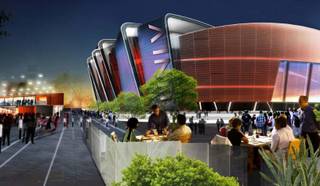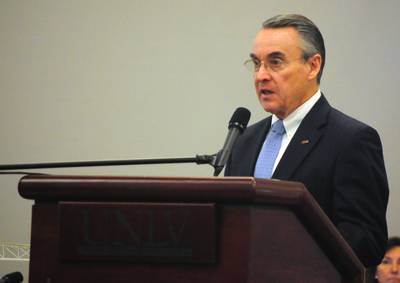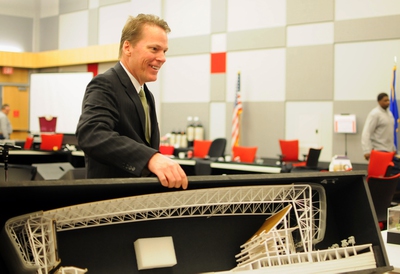Tuesday, May 7, 2013 | 2 a.m.
Related stories
- Timeline of UNLV-Majestic breakup (5-07-2013)
- Regent questions priorities behind UNLV Now stadium project (4-20-2013)
- Why UNLV’s decision to drop partner in stadium project could be risky (3-29-2013)
- Project leader still bullish on UNLV Now stadium (2-15-2013)
- Ray Brewer: Answering questions about the proposed UNLV Now stadium project (1-19-2013)
- Ray Brewer: New stadium would be major score for city, instant program changer for UNLV football (1-12-2013)
- Funding plan for new UNLV stadium still relies on tax infusion (3-1-2012)
UNLV mulled the idea of dropping Majestic Realty nearly a month before making its decision public, according to emails between the two former UNLV stadium partners.
The Las Vegas Sun, through a public records request, recently obtained more than 1,000 pages of emails between UNLV Now project leader Don Snyder and Majestic point man Craig Cavileer.
The emails, sent between January and March, offer a glimpse into the reasons why UNLV ended its two-and-a-half-year partnership with Majestic.
"It wasn't an overnight decision, and it wasn't a decision made in haste," Snyder said last week. "There was a lot of thoughtful consideration given to it."
•••
When Majestic approached UNLV with its stadium idea in 2010, the partnership between the two had seemed like a match made in heaven.
UNLV and Majestic's leadership had ties with each other.
UNLV Hotel College Dean Don Snyder sits on the same board at Las Vegas-based Switch Communications as Majestic CEO Ed Roski, who was the driving force behind the development of the Staples Center in Los Angeles.
Snyder first met Roski 25 years ago. Snyder was with First Interstate Bank of California and was the former real estate banker for Majestic.
Roski's point man for the UNLV stadium project — Silverton Casino President Craig Cavileer — also sits on the board of the UNLV Foundation.
Coupled with Snyder's expertise in public-private developments such as the Fremont Street Experience and the Smith Center, the UNLV-Majestic team had high hopes for the development of a 60,000-seat domed stadium on UNLV's campus.
The idea was this "mega-events center" — dubbed UNLV Now — would help transform UNLV's campus and attract hundreds of millions of dollars to Southern Nevada. Proponents called the stadium project, which includes a student village, a "game-changer" for the young university vying to become a top-tier academic and athletic institution.
However, the project hit several roadblocks:
• A bill to create a special tax district on campus to finance the stadium's construction failed in the final days of the 2011 legislative session. A similar bill is being discussed this session in Carson City.
• MGM Resorts International and the Nevada Resorts Association issued statements earlier this year that raised concerns about the cost of the project, estimated around $900 million. UNLV is seeking support from the six largest resorts in Las Vegas as well as the Las Vegas Convention and Visitors Authority.
• The Federal Aviation Administration warned developers that the proposed stadium, situated just miles from McCarran International Airport, was too tall and therefore hazardous to planes.
•••
Behind these public challenges, disagreements between UNLV and Majestic were mounting behind the scenes, according to emails between the two parties.
Majestic wanted UNLV to move more quickly to make the stadium project a reality. The developer also was concerned about the release of financial documents shared with the public university.
In several emails, Cavileer raised issues about the university's dealing with local media, particularly the release of information on how UNLV and Majestic planned to finance the stadium. Cavileer did not return a request for comment.
"Craig had talked about his frustrations about the pace working with the university and the public sector as a whole," Snyder said. "I told Craig, 'Look, I understand the challenges of the public sector-private sector partnership. If you don't have the stomach for it, no harm, no foul.
"But you have to realize that this is a process that has to be much more open and much more transparent than you're used to with a private development," Snyder said. "These types of developments that involve the public sector, they are complex. There are a lot of moving parts. There are a lot of complications."
UNLV officials also were concerned about the perception of having Majestic as the lead for the project.
When the project started in 2010, Cavileer had been the face and voice behind it. After all, this was Majestic's idea and the company was footing the bill for research and development planning.
Earlier this year, however, Snyder became the face of UNLV Now after receiving feedback last legislative session from lawmakers.
"There was certainly some confusion with regard to whose project it was," Snyder said. "In a redevelopment project like this on the university's land, it's clear to me that the university needs to be the owner (of this project)."
•••
On March 27, when UNLV announced its decision to drop Majestic, Snyder explained it was part of the evolution of the stadium project.
Over the past three years, UNLV Now became more than just a traditional college football stadium, Snyder said. UNLV Now was a "mega-events center" that could host major sporting and music events to a crowd of 60,000 visitors to the Strip nearby.
"As the project morphed, it became increasingly clear it really needed to be a partnership between the university and the resort industry," Snyder said. "That is where it became increasingly difficult and complicated to have a third party standing between the two primary partners in this partnership."
Observers have speculated whether powerful forces in the resort industry on the Strip swayed UNLV's decision to drop Majestic, which owns the Silverton — a competitor to Strip casinos. Some have speculated there might have been a quid pro quo arrangement that resulted in Majestic’s ouster.
An anonymous source told the Las Vegas Review-Journal that MGM had pledged to support the UNLV Now stadium before Majestic was dropped. When this occurred and what MGM’s support means is unknown.
Two weeks before Snyder told Cavileer of UNLV's desire to end its partnership with Majestic, UNLV Now officials met with Steve Wynn, who spoke with Sheldon Adelson about the stadium project.
The two Las Vegas casino magnates met to discuss the project about five days before Snyder first expressed UNLV's desire to drop Majestic to Cavileer, according to the emails.
Snyder dismissed suspicions that MGM, Wynn or Adelson had something to do with Majestic's ouster as "garbage."
"It's not about Majestic, what Majestic did or didn't do," Snyder said. "The structure that we started with isn't the structure that will, at the end of the day, get this facility built. That's why we made the change. It's as simple as that."
•••
By the end of this month, Majestic will officially be out of the UNLV Now project. So now what?
UNLV is taking a step back to discuss the stadium project with the larger resort community, Snyder said.
"There has to be a good, open, direct dialogue with the industry," he said. "The industry has to feel they have a voice and their voice is going to be heard."
In January, UNLV Now officials began meeting with casino executives in town to drum up support for the stadium project. At that point, plans for the stadium were quite developed. Snyder now calls that a mistake.
"If I were to put myself back in as president of Boyd Gaming and listen to the presentation where we had the model, video screen and all the amenities plugged in and we were trying to get their support, I could see myself saying, 'Wait a minute, are you really looking for my input or are you just looking for me to go along with what you're proposing?'" he said. "There needs to be some consensus building."
All aspects of the current UNLV stadium plans must be re-evaluated, including its size and amenities, Snyder said.
Some casino executives liked the 100-yard-long video screen, purported to be the largest in the world. Others didn't.
Some resorts also took issue with UNLV Now's nightclubs, possibly because it may compete against popular nightclubs on the Strip.
Snyder believes an authority overseeing the proposed tax-increment financing district on campus would help facilitate public discussions between UNLV and the resort industry over the specific details of the stadium.
"Inserting (Majestic) between these two partners created the potential for too much noise as to what that private partner gets out of this development," Snyder said. "It's that type of thing that got in the way of creating the consensus that we needed.
"So it's nothing negative about Majestic. It is just the evolution of the deal."





Join the Discussion:
Check this out for a full explanation of our conversion to the LiveFyre commenting system and instructions on how to sign up for an account.
Full comments policy